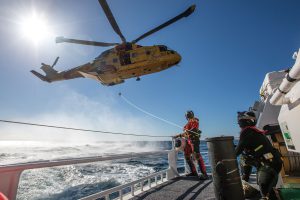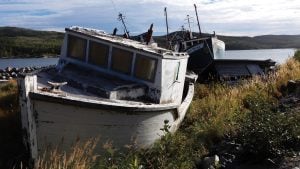
People & Culture
Safety first, service always: The Canadian Coast Guard turns 60
A celebration of the Canadian Coast Guard’s renowned search-and-rescue capabilities — and more — as the special operating agency turns 60
- 4392 words
- 18 minutes
This article is over 5 years old and may contain outdated information.
History

Photo: An investigative team reassembles a Nazi weather station in Labrador. Read the full story from the Dec. 1981/Jan. 1982 issue of Canadian Geographic here. (Photo: Canadian Geographic archives)
In 1980 Alec Douglas, the official historian of the Canadian Armed Forces, received a call from a German author conducting research for a book on Nazi weather stations in the Second World War; the author had found reference to a previously unknown post on the northern tip of Labrador.
“I was intrigued but skeptical,” wrote Douglas in the Dec. 1981/Jan. 1982 issue of Canadian Geographic [read the story here]. “Even if a U-boat has slipped into the Labrador waters undetected…radio transmissions from the region would surely have resulted in a search and an intelligence report.”
But Douglas found no Canadian record of the station. Documents from the Operations Intelligence Centre in Ottawa were disposed after the war, and other military records, while noting U-boat sightings in Canadian waters, referenced nothing off the coast of Labrador.
While investigating German war documents, Selinger uncovered an old picture worth a thousand clues. It was of an IXC U-boat, usually chosen for distant operations, without its distinctive armament. The background of the photo was strange; massive weathered rocks sloped from the shore, very different terrain than in other images at that time.
Then Selinger discovered the log of U-537.
“Its task was to set up an automatic weather station on the Labrador Coast…Starting from a bearing off Cape Chidley at the northern tip of Labrador, [the captain] ran slowly down the coast…and on October 22, 1943, anchored just inside [Martin Bay],” wrote Douglas. “The U-boat stayed long enough to verify the station was functioning properly…and then slipped out to sea. The operation had taken 28 hours.”
The log was enough to convince the historian of its validity, and he along with Selinger set out on the Canadian Coast Guard icebreaker, Louis S. St. Laurent, in July 1981. What they found at the Martin Bay weather station was baffling.
“Every canister had been opened and the contents strewn about for a distance of 100 feet or so. Batteries and radio parts seemed to have been systematically dismantled…Underneath one canister was a clue: a single .303 rifle cartridge bearing the inscription ‘British Dominion.’”
Douglas and Selinger posited a few theories as to who dismantled the station and when, but nothing could be proven. The only certainty was that this station existed right under Canada’s nose, and the Nazi’s undertook an incredibly dangerous, and stealthy, mission to put it there.
Are you passionate about Canadian geography?
You can support Canadian Geographic in 3 ways:

People & Culture
A celebration of the Canadian Coast Guard’s renowned search-and-rescue capabilities — and more — as the special operating agency turns 60

Science & Tech
How the Joint Arctic Weather Stations program did more than just fill in a blank on the nation’s weather map

Travel
Immerse yourself in Viking archaeology and Basque whaling history while taking in Newfoundland’s scenic coastline and incredible geology

People & Culture
A moratorium on cod fishing that was supposed to last two years has now lasted 30. What will it take to rebuild cod stocks — and a way of life?